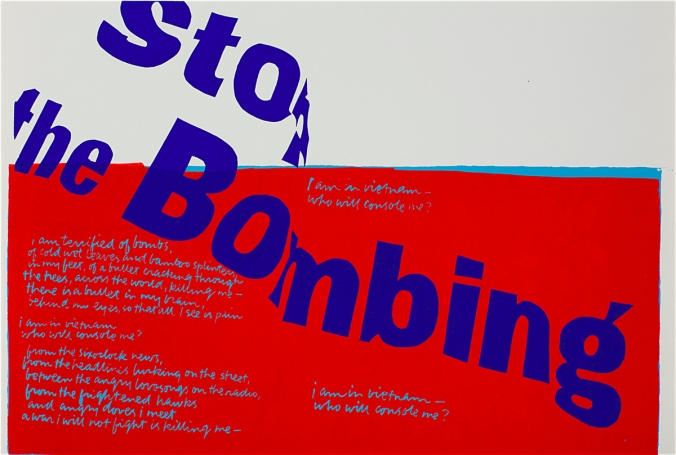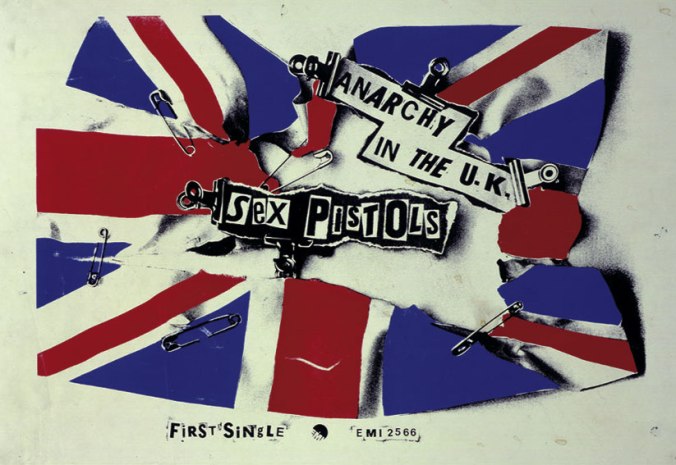
Image source: https://www.sfmoma.org/artwork/2008.8
Sister Mary Corita, also known as Corita Kent (1918–1986), was an artist, educator, and advocate for social justice. At age 18 she entered the religious order Immaculate Heart of Mary, eventually teaching in and directing the art department at Immaculate Heart College. Kent was at the forefront of a movement by the Catholic Church in the 1960s to make the church more modern and relevant in modern society. Her art was one of the most successful methods of doing so, exhibiting a marriage of pop culture and contemporary issues with messages of faith and the power of God at a critical period of political unrest.
Kent’s work incorporates advertising images and slogans, popular song lyrics, biblical verses, and literature. Throughout the 1960s her work became increasingly political, urging viewers to consider poverty, racism, and injustice.[1] These political messages in her art reflects on the serious issues of the time, including the civil rights movement, the assassination of Robert F. Kennedy and the Vietnam War.[2]
One of Kent’s screen-printed pieces displayed in the exhibition Sister Corita’s Summer of Love is a powerful protest against the Vietnam War, titled “Stop the Bombing” 1967. The bold and powerful statement, “Stop the Bombing” is distorted and slanting, representative of the perverted nature of the Vietnam War. The poetic words that sit in the striking red block deliver a sense of helplessness. The handwritten-style words comment on the news, further advocating the unrelenting impact these issues have on the world. Kent conveys a message of hope for civil rights and an end to the Vietnam War.
Transcribed text:
Stop the Bombing
I am in Vietnam – who will console me?
I am terrified of bombs, of cold wet leaves and bamboo splinters in my feet, of a bullet cracking through the trees, across the world, killing me – there is a bullet in my brain, behind my eyes, so that all I see is pain
I am in Vietnam – who will console me?
from the six-o-clock news, from the headlines lurking on the street, between the angry love songs on the radio, from the frightened hawks and angry doves I meet a war I will not fight is killing me –
I am in Vietnam – who will console me?
Kent’s aim was to make her work as democratic as possible. “It’s why screen-printing was her medium of choice,” says Ray Smith director at the Corita Art Center. “She wanted her work to be low priced and accessible. It was everywhere.” [3] Kent’s philosophy directly correlates to that of the Australian community arts collective RedPlanet, advocating parallel issues to Kent, like the Vietnam War, through the screen-printed poster. The main goal driving both Kent and RedPlanet was a mode of creative and political expression that generated a direct and bold political message, rather than one of self-expression. Screen printing made it possible for both parties to explore the idea and belief that, as a matter of principle, it was everybody’s right to participate in the shaping of the world in which they lived.[4] The production of these highly charged political posters were created by two different organisations, in two different countries, across two different periods of time, both existing in and responding to relevant social and political issues, with the common conviction that art can be produced collectively to make political statements and influence social action.
Kent’s work reflects the dynamism and issues of the times in which she lived, while maintaining and communicating a sense of optimism and hope. Despite being made over 50 years ago her messages of resistance and opposing injustice remain incredibly relevant for the world today and continue to speak to contemporary audiences.
[1] “The Corita Art Center.” Corita Kent. http://corita.org/about-corita
[2] “Sister Corita’s Summer of Love.” Right Now. March 01, 2017. http://rightnow.org.au/review-3/sister-coritas-summer-love/
[3] “The Poster Art of Sister Mary Corita Kent.” KCET. June 15, 2015. https://www.kcet.org/shows/artbound/the-poster-art-of-sister-mary-corita-kent?utm_source=facebook&utm_medium=social&utm_campaign=artbound
[4] Tsara, Olga. “The Art of Revolution Political Posters in the RedPlanet Archive.” The La Trobe Journal, 2005, 94-112.
